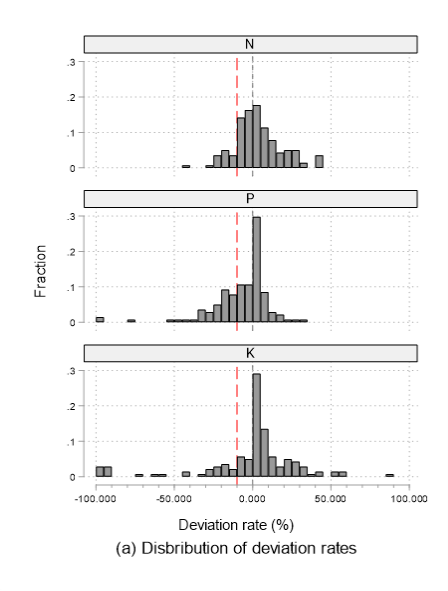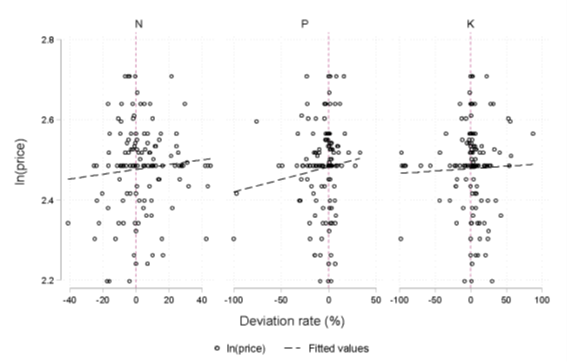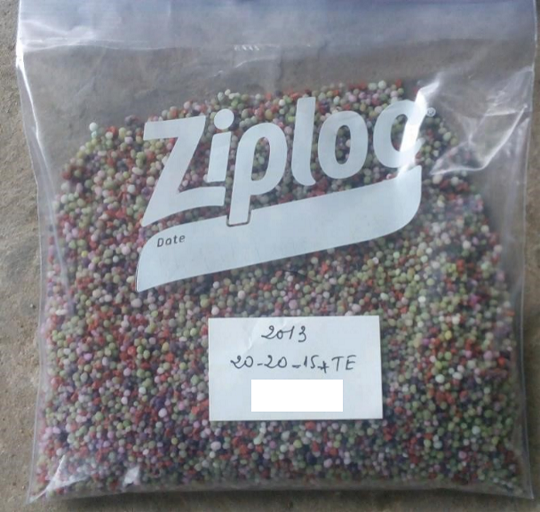IDE Research Columns
Column
How to Govern the Quality of Fertilizer: Lessons from Vietnam
Yutaka ARIMOTO
Hitotsubashi University
June 2022
The governance of fertilizer quality is important to food policy because the prevalence of low-quality fertilizers discourages fertilizer use and stagnates agricultural productivity growth. This column discusses the current condition of fertilizer quality and describes the initiatives taken against the problem in Vietnam. We report that average fertilizer quality is fair, and farmers expressed no concerns over fertilizer quality—contrasting what has been reported for sub-Saharan Africa. Vietnam’s fertilizer market is governed by three initiatives: government regulations and controls through licensing, mandatory quality labeling, and random inspections; producers’ effort to maintain quality and brand through warranty and dealer certifications; and hierarchical social learning through which a farmer’s quality assessments about fertilizer quality are aggregated to retailers who then update product assortments on the basis of reputations. The importance of public regulations is highlighted through a discussion on how government and market initiatives interact and complement each other.
Background and Motivation
The use of chemical fertilizers is a premise for modern agriculture (Hayami and Ruttan 1985). Yet, low adoption and underutilization of fertilizers are often reported in developing countries, especially in sub-Saharan Africa (Evenson and Gollin 2003; Foster and Rosenzweig 2010; Njeru et al. 2015), leading to the stagnation of agricultural productivity and the vulnerability of food security.
Why do farmers underapply fertilizer? Studies pointed out a range of reasons, from the lack of knowledge, credit constraints, procrastination on fertilizer purchases, high risk, and significant variability in cost-effectiveness (Foster and Rosenzweig 2010; Magruder 2018; Macours 2019). In this study (Kojin et al. 2022), the focus is on a relatively less studied hypothesis: the product is of low-quality or even fake. Farmers refrain from using fertilizers if they perceive that the quality is poor.
Although this mechanism—on the basis of the quality issue—may be too obvious, it is theoretically important and very practical in developing countries. Rumors are heard in the field about fake agricultural inputs, such as seeds, fertilizer, pesticides, and medical drugs, and evidence of these problems has accumulated (Ashour et al. 2018; Björkman-Nyqvist, Svensson, and Yanagisawa-Drott et al. 2022; Bold et al. 2017; Hoel et al. 2022; Michelson et al. 2021). A common feature of these goods is that consumers cannot correctly infer the quality at purchase and even after usage because the observable outcome (e.g., crop growth) is affected by the nutrient contents of the fertilizer and other noise, such as weather conditions and agricultural practices. Therefore, “bads” cannot be driven out of the market by the usual mechanism that consumers stop buying products of (seemingly) low-quality. Therefore, public and private initiatives are necessary.
Purpose of This Study
This study has two purposes: to investigate the fertilizer quality in the market and to identify and describe public and market initiatives that govern fertilizer quality in Vietnam. Vietnam is an interesting case because it has seen increased fertilizer application and rapid rice productivity growth since the 1980s—despite suffering from the prevalence of low-quality fertilizers. Both public and market initiatives have been established, raising expectations that the quality of fertilizers in the market is under control.
Results of Fertilizer Quality
Three major nutrients—nitrogen (N), phosphate (P), and potassium (K)—were tested from 141 samples of fertilizers collected from retail stores in the Mekong Delta region. The result showed that the average quality was fair. The average deviation rates, defined as the percentage deviation of the actual nutrient from the nutrient level stated on the label, were 3.2% for nitrogen, −7.8% for phosphate, and −1.4% for potassium. The phosphate content seems low but cannot be ruled out as being within the margin of error.

Figure 1.Distribution of Deviation Rates by Nutrient
Source: Kojin et al. (2020, Figure 3)
Note: The figure depicts histograms of the distribution of deviation rates. The horizontal axis shows the deviation rate, where 0 indicates that the actual nutrient content is the same as labeled. The red dashed line at −10% indicates the legally acceptable level of the deviation rate.
However, variability existed among samples. Some contained fewer nutrients than noted on the label (Figure 1). Whereas approximately one-third of the samples were accurately produced and had the exact content level as labeled, half (49%) of the samples had at least one substandard nutrient with a deviation rate less than −10%, the legally acceptable threshold. Interestingly, price was positively correlated with deviation rate but was too noisy to be useful in indicating quality (Figure 2).

Figure 2. Price and Deviation Rate
Source: Kojin et al. (2022, Figure 4)
Note: This figure depicts the relationship between the deviation rates and price and shows that the price is higher for fertilizer samples with higher deviation rates.
In summary, the finding shows that, on average, farmers can purchase a fertilizer with fair quality from the market; however, the chance exists that they purchase a low-quality product.
Findings on Government and Market Initiatives
How is fertilizer quality governed (on average) when consumers cannot distinguish goods from bads? The second purpose of this study is to investigate the institutions and initiatives that constitute or surround the supply chain of fertilizers that potentially governs quality. Three initiatives were identified through in-depth field observations and interviews with stakeholders.
The first initiative is government control, which comes with a standard package of regulations, including licensing and certification at production, distribution, retail, and inspection stages; mandatory quality labeling; and random inspections. During the field survey on fertilizer retailers, these regulations were observed to have been followed: producers and retailers hold necessary licenses and certificates; nutrient contents are labeled on bags, and the local government conducts random inspections.
The second initiative is producers’ efforts to maintain quality and brand. Much of the Vietnamese fertilizer market is occupied by major, large-scale enterprises, and their logos and brands are well-recognized. To strengthen their reputations, some producers offer warranties to retailers for losses caused by quality issues. Others have introduced a dealer certification that ensures that the dealer has received training and is knowledgeable about the product. These measures help retailers and consumers form the belief that their products are genuine and of good quality.
The third initiative is learning and reputation building among farmers and retailers. Farmers attempt to infer fertilizer quality on the basis of observable features, such as crop growth and leaf colors. Farmers exchange such information on fertilizer quality and with retailers as feedback on complaints. Retailers then update product assortments by excluding products with bad reputations and those publicly detected as illegal. Therefore, a potentially efficient social learning process exists in which farmers’ independent assessments of quality are concentrated and accumulated with retailers who ultimately decide whether to continue to sell the product.
Discussion and Policy Implications
Our finding suggests that the (mis)perception of fertilizer quality or the underutilization because of quality issues is not prevalent in Vietnam. The average quality of fertilizers in Vietnam is fair, and farmers expressed no concerns over it. They did not claim adjusting their fertilizer use because of quality concerns. This finding contrasts with the situation in sub-Saharan Africa, where possible quality issues or farmers’ (mis)perceptions and low fertilizer application are reported (Bold et al. 2017; Hoel et al. 2022; Michelson et al. 2021).
What is the difference when compared with the situation in sub-Saharan Africa? This descriptive approach cannot make a causal claim that the three initiatives drove out low-quality fertilizers. However, a comprehensive view is also useful to understand the context in which the case is embedded. Given that Vietnam controls low-quality fertilizer, which was formerly prevalent, the conclusion is that the “standard” package of initiatives is important. This finding seems reasonable because no silver-bullet policy can be identified as having been implemented in countries free from low-quality fertilizers.
Thus, implementing government regulations on licensing, minimum quality standards, mandatory quality disclosure (labeling), and inspections seems necessary. Even though quality cannot be perfectly observed, the theoretical possibility is that social learning may remove “bads” from the market but only given certain limited conditions (Bold et al. 2017). Hence, inspections are ultimately essential to eradicate the problem. The government should provide a set of institutions to assure the quality of fertilizer as a public good. That these regulations are not only enacted but also implemented through continuing and frequent inspections is important, which requires a certain administrative capacity.
If such administrative capacity is limited, then the role of market initiatives becomes more relevant and important. The Vietnamese case suggests that reputation building is possible through corporate effort such as branding, warranty, and authentic dealer certifications. Competition between producers allows consumers to compare products with different qualities and helps farmers detect poor quality fertilizer (Björkman-Nyqvist, Svensson, and Yanagisawa-Drott 2022). Consumers must have the option to verify producer claims regarding their products’ quality. Inspections and requested testing services by a third party are necessary to complement the market initiatives and add credibility to producers’ signaling.
Future studies may investigate policies that elicit and support market initiatives given limited administrative capacity. The complementarity of government regulations and market initiatives could make it interesting to investigate the effect of the frequency of inspections and inspection announcements and offer requested testing services that allow consumers to ask for third party quality testing to verify quality.
Another remaining question is the case of sub-Saharan Africa. Recent studies reported that the fertilizer quality is fine but that the actual problem is farmers’ misperception of low-quality. The question remains as to whether fertilizer quality is indeed sufficient and, if so, how the problem was resolved given circumstances in which social learning is dysfunctional (because farmers hold misperceptions about quality), and the regulation is ineffective.
References
Ashour, Maha, Daniel Orth Gilligan, Jessica Blumer Hoel, and Naureen Iqbal Karachiwalla. 2018. “Do Beliefs about Herbicide Quality Correspond with Actual Quality in Local Markets? Evidence from Uganda.” Journal of Development Studies 55(6): 1285–306.
Björkman Nyqvist, Martina, Jakob Svensson, and David Yanagizawa-Drott. 2022. “Can Good Products Drive out Bad? A Randomized Intervention in the Antimalarial Medicine Market in Uganda.” Journal of the European Economic Association (forthcoming).
Bold, Tessa, Kayuki C. Kaizzi, Jakob Svensson, and David Yanagizawa-Drott. 2017. “Lemon Technologies and Adoption: Measurement, Theory and Evidence from Agricultural Markets in Uganda.” Quarterly Journal of Economics 132(3): 1055–100.
Evenson, Robert E., and Douglas Gollin. 2003. “Assessing the Impact of the Green Revolution, 1960 to 2000.” Science 300(5620):758–62.
Foster, Andrew D., and Mark R. Rosenzweig. 2010. “Microeconomics of Technology Adoption.” Annual Review of Economics 2:395–424.
Hayami, Yujiro, and Vernon W. Ruttan. 1985. Agricultural Development: An International Perspective, rev. ed. Baltimore: Johns Hopkins University Press.
Hoel, Jessica B., Hope Michelson, Ben Norton, and Victor Manyong. 2022. "Misattribution and Uncertainty about Beliefs Prevent Learning." mimeograph. Last modified May 20, 2022. https://www.dropbox.com/s/fad4yfsjpdjrywd/Hoel_Learning_2022may20.pdf?dl=0
Kojin, Emi, Do Van Hoang, Nguyen Thiet, Yutaka Arimoto, Vo Hong Tu, Yukichi Mano, Nguyen Duy Can, Kazunari Tsukada. 2022. “Governance of Fertilizer in Vietnam: Governmental and Market Initiatives.” IDE Discussion paper 840. http://hdl.handle.net/2344/00052973
Macours, Karen. 2019. “Farmers’ Demand and the Traits and Diffusion of Agricultural Innovations in Developing Countries.” Annual Review of Resource Economics 11:483–99.
Magruder, Jeremy R. 2018. “An Assessment of Experimental Evidence on Agricultural Technology Adoption in Developing Countries.” Annual Review of Resource Economics 10:299–316.
Michelson, Hope, Anna Fairbairn, Brenna Ellison, Annemie Maertens, and Victor Manyong. 2021. “Misperceived Quality: Fertilizer in Tanzania.” Journal of Development Economics 104, 102579.
Njeru, Timothy N., Yukichi Mano, and Keijiro Otsuka. 2015. “Role of Access to Credit in Rice Production in Sub-Saharan Africa: The Case of Mwea Irrigation Scheme in Kenya.” Journal of African Economies 25(2): 300–21.
*Thumbnail image: Fertilizer (Getty images)
**Photo: A bag of fertilizer (by the author)
***The views expressed in the columns are those of the author(s) and do not represent the views of IDE or the institutions to which the authors are attached.


